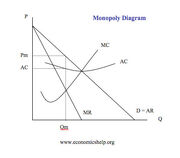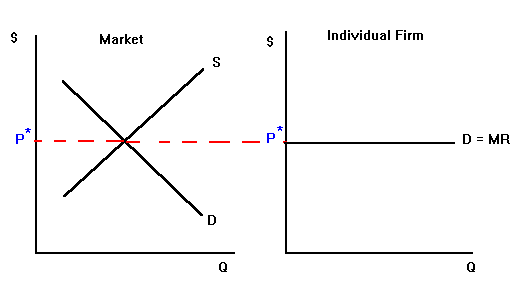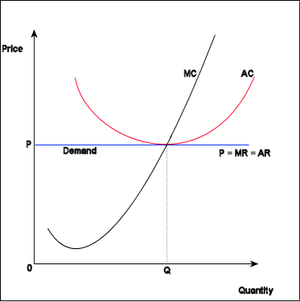
In economics, perfect competition occurs in markets in which no participant has market power. Because the conditions for perfect competition are strict, there are few if any perfectly competitive markets. Nonetheless, the concept of perfect competition can serve as a useful benchmark against which to measure real life, imperfectly competitive markets.
Assumptions[]
- There are many firms competing in the market. A single firm cannot influence the total market output and/or price. The firm is a price-taker.
- All firms in a perfectly competitive market are producing homogeneous goods (identical goods).
- All firms are short run profit maximizers, where the point of equilibrium where MC=MR.
- There is perfect knowledge and information between the firms and consumers in terms of any improvements in the technology or the manufacturing of the good or service.
- There are no barriers to entry.
- General market environment a firm expects to operate in over the life of a financial plan.
- Homogeneous products are supplied to the markets that are perfect substitutes. This leads to each firms being passive “price takers” and facing a perfectly elastic demand curve for their product.
- No externalities arising from production and/or consumption which lie outside the market.
Demand curve facing the industry and the firm[]
The demand curve for a perfectly competitive market (PCM) firm varies significantly from that of the industry. As shown in the diagram below, the demand curve for a PCM is your traditional downward-sloping demand curve and could represent the demand for iron, potatoes, or any number of homogenous goods. One of the most important assumptions of the PCM model is that firms are price takers. Due to the goods that any individual firm produces are identical to those of the other firms, the only way in which firms can compete is by adjusting their prices. Once the price has been determined by the market supply and demand forces, any individual firm becomes a price-taker. If the firm sells its goods at a price that is higher than the equilibrium price, they simply will not sell. Furthermore, assuming that the firm is a profit maximiser in the short-run (as established by the PCM model) the firm will sell its goods at the highest possible price, namely, the market price. Therefore, the demand curve for the PCM firm must be horizontal as shown below. This also makes sense in terms of quantity produced because as there are a large number of firms (yet another assumption of the PCM model) any individual firm's production will have no impact on the overall supply of the good produced.
Picture courtesy of David A. Latzko of Pennsylvania State University.
Profit-maximizing level of output and price[]
A PCM firms are trying to maximize their profits in either the short or long-term and will produce the quantity at which MC = MR. Because the firm is a price-taker, the price is set by the market forces of supply and demand. There are three possible outcomes fore the PCM firm in the short-run. If the ATC curve intersects the MR curve at its lowest point, the firm will break even or earn a normal economic profit as shown below in the first diagram. If the lowest point of the ATC curve lies below the MR curve, the PCM firm will earn an "abnormal profit." The yellow box in the second diagram represents the value of the abnormal profit. Finally, if the lowest point of the ATC curve is above the MR curve, the PCM firm will make a loss, represented by the pink box in the third diagram.
Short-run abnormal profits/losses[]
In the short-run, it is possible for a PCM firm to earn either an abnormal profit or loss. Let's consider the case of earning an abnormal profit first. As mentioned in the previous section, this occurs when the minimum point of the ATC curve lies below the MR curve. Assuming perfect information, firms not already on the market will notice that the aforementioned firm is earning an abnormal profit. Eager to get in on the action, some of these firms will enter the market, especially since there are no barriers to entry. This subsequent increase in supply causes the price to fall. New firms will continue entering the market and the price will continue to fall until the first firm earns a normal economic profit once again.
Now let's turn to a PCM firm earning a loss. As mentioned in the previous section, a firm makes a loss when the minimum value of the ATC curve lies above the MR curve. This may occur if too many firms have entered the market. Over time, some firms will leave the market. This decrease in the supply of the good will cause it's price to increase. Firms that are able to "ride out the storm" will find that they are no longer earning a loss, but a normal economic profit.
Long-run normal profit[]
As you probably realized upon reading the last section, in the long-run a PCM firm will earn a normal economic profit. It cannot earn an abnormal profit in the long-run because firms will enter the market and the subsequent increase in supply will cause the price of the good to fall. Conversely, the firm cannot earn a loss(provided it can cover its fixed costs) in the long-run because firms will leave the market and the subsequent decrease in supply will cause the price of the good to increase.
Shut-down price, break-even price[]
A company has broken even when its total sales or revenues equal its total expenses. when a company breaks even there is no profit that has been made, nor have any losses been incurred. A firm's shut down price is when it's average variable cost curve is above the marginal revenue curve. When this is true, it is only a matter of time before the firm must leave the market. When firms leave a market, the supply decreases, raising the profits of the firms who stay in the market.
Efficiency in perfect competition[]
5 reasons why Perfect Competition is efficient:
1. Allocative Efficient: This is because P = MC.
2. Productive Efficient: Firms produce where MC=ATC.
3. X Efficient: Competition between firms will act as a spur to increase efficiency.
4. Resources will not be wasted through advertising because products are homogenous.
5. Normal profit means consumers are getting the lowest price. This also leads to greater equality in society.



